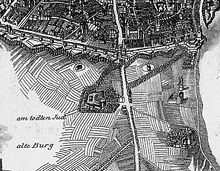Judenbüchel

The Judenbüchel ("Am Toten Juden"), called Dude Jüd in the Cologne language , was a Jewish cemetery in Cologne-Raderberg .
history
When it was created and its exact size are not documented. The first known source comes from the middle of the 12th century. This mentions a courtyard next to which the cemetery should be. Another document reports the expansion of the cemetery by five acres of land for 1174 . The Jewish community paid the provost of St. Severin , who owned the property, an annual rent for this property .
1,349 were Jews for those plague - epidemic blamed. The city's Jewish quarter was stormed and devastated by citizens of Cologne during the persecution of the Jews at the time of the Black Death . Many Jews were murdered and the neighborhood ransacked. The gravestones on the Judenbüchel were desecrated and used as building material. It was not until 1372 that the cemetery was returned to the newly established Jewish community . Even after the expulsion of the Jews in 1424 and settlement in Deutz on the right bank of the Rhine , the cemetery was still occupied. In 1474 it was destroyed during the siege of Cologne by Charles of Burgundy . Nevertheless, the burial site was only moved to Deutz at the end of the 17th century.
In 1922, the cemetery was exposed again through construction work for the Bonntor and by widening the road. The bones of the dead were then reburied. After desecrations from 1928 to 1934, the final abandonment was decided in 1936 . The bones and some gravestones were reburied in the Jewish part of the cemetery in Bocklemünd and, over time, a memorial stone was attached to remind of the history of the Judenbüchel. Another memorial plaque is located at the main gate of the Raderberg wholesale market , which was built on the cemetery in 1936. Today the Cologne wholesale market is located on the site.
Execution site

The cemetery was also used as a public place of execution in the Middle Ages. The first executions began in 1163, but were banned in 1266 by a decree by Archbishop Engelbert II . In this decree he assures the Jewish community that the burial place is inviolable. From 1474 the court of the city of Brühl used the place again for public executions. They had to pay the rent that the Jewish community had previously paid to the Severinsstift. During the construction work in 1922, skeletons of those executed were also found in the cemetery. There was another place of execution opposite today's Melaten cemetery .
Other uses
An infirmary was first mentioned on the site in 1463. Due to its convenient location, the free area of the cemetery was also used profanely for larger events. Weddings and tournaments were held here. A public tournament has been recorded for the year 1384.
literature
- Carl Dietmar, Marcus Trier : With the subway to Roman times. A manual to the archaeological excavation sites around the construction of the north-south light rail. 2nd Edition. Kiepenheuer & Witsch, Cologne 2006, ISBN 3-462-03575-4 , p. 234 f.
- Hermann Keussen : Topography of the city of Cologne in the Middle Ages (= price publications of the Mevissen Foundation 2, ZDB -ID 520567-0 ). 2 volumes. Hanstein, Bonn 1910 (reprint, taking into account the revised special print Bonn 1918. ISBN 3-7700-7560-9 (vol. 1), ISBN 3-7700-7561-7 (vol. 2)).
- Joseph Rosenzweig: Between Judenbüchel and Sauacker. In the south of Cologne on Bonner and Brühler Strasse. Heimatverein Köln-Raderthal-Raderberg-Arnoldshöhe, Cologne 1982.
- Matthias Schmandt: Judei, cives et incole. Studies on the Jewish history of Cologne in the Middle Ages (= research on the history of the Jews. Department A: Abhandlungen. Vol. 11). Hahn, Hanover 2002, ISBN 3-7752-5620-2 (also: Trier, Univ., Diss., 2000).
See also
Web links
- Information from the city of Cologne
- Entry for the Jewish cemetery on Bonner Strasse in Raderberg (Judenbüchel, Am Toten Juden, “Dude Jüd”, Jewish cemetery at Bonntor) in the “ KuLaDig ” database of the Rhineland Regional Association
Individual evidence
- ↑ a b Dietmar, Trier: With the subway to Roman times. 2006, p. 235.
- ↑ Richard Knipping: The Regests of the Archbishops of Cologne in the Middle Ages. Volume 3: 1205-1304. Half volume 1: 1205–1261 (= publications of the Society for Rhenish History 21, 3, 1). Droste, Düsseldorf 1909, p. 280, No. 1233 (reprint, ibid. 1964).
- ^ Keussen: Topography of the City of Cologne in the Middle Ages. Volume 1, p. 154 ff.
Coordinates: 50 ° 54 ′ 44.7 " N , 6 ° 57 ′ 30.7" E



